Picture this: It’s a warm March morning in Central Texas. You open the back door with your coffee, and suddenly you’re standing under a living fireworks display of electric-purple blossoms. Bees are buzzing like tiny helicopters, a hummingbird zips past your ear, and your neighbor across the fence actually stops mid-dog-walk to take a photo. That, my friends, is the magic of the perfect purple flower tree Texas homeowners dream about.
Every single week I get the same excited message: “Sarah, I keep seeing this gorgeous purple flowering tree all over Austin/Dallas/Houston/San Antonio — what is it and can I grow it in my yard?!” The answer is almost always YES — but only if you pick the right species for our brutal summers, unpredictable winters, caliche clay, or sandy coastal soil.
After 15 years of planting thousands of trees across every Texas region from the Panhandle to the Rio Grande Valley, I’ve narrowed it down to the 7 absolute best purple-flowering trees that not only survive here — they absolutely thrive and steal the show. In this ultimate guide you’ll discover:
- Exact identification of the trees you’re seeing on your drives
- Which ones are truly native (and which ones just act like they are)
- My proven planting and care playbook so yours lives for decades
- Region-by-region recommendations because Lubbock is NOT Houston
Let’s turn your yard into the one everyone slows down to admire 🌳💜
1. Why Purple-Flowering Trees Are Perfect for Texas Landscapes 🌿
Purple isn’t just a color — it’s a mood-lifter backed by science. Studies from Texas A&M AgriLife show that purple flowers reduce stress hormones more effectively than any other hue. Pair that with our endless blue skies and green live-oak backdrop, and purple blooms create the highest possible contrast — your tree becomes living art.
Plus, native bees and hummingbirds go crazy for purple tubular flowers. One mature Vitex or Texas Mountain Laurel can support hundreds of pollinators in a single season.
2. The 7 Best Purple Flower Trees for Texas (Ranked by Popularity & Performance)
2.1 Texas Mountain Laurel (Sophora secundiflora) – The Grape Kool-Aid Tree 🌸🍇
Hands-down the #1 tree Texans message me about every spring.
- Bloom time: March–April (sometimes into May in Hill Country)
- Flower: Intensely fragrant wisteria-like clusters that smell exactly like grape bubble gum
- Mature size: 15–25 ft tall × 10–15 ft wide (slow grower)
- USDA zones: 8–10 (perfect from San Antonio west and south; marginal in DFW without protection)
- Native status: 100% Texas Hill Country native
- Drought tolerance: Extreme once established
- Deer resistance: High (toxic seeds)
Pros & Cons Table
| Pros | Cons |
|---|---|
| Insanely fragrant | Very slow growing (3–5 ft in 5 yrs) |
| Evergreen glossy leaves | Toxic seeds (keep away from kids/dogs) |
| Zero pest problems | Hates wet feet |
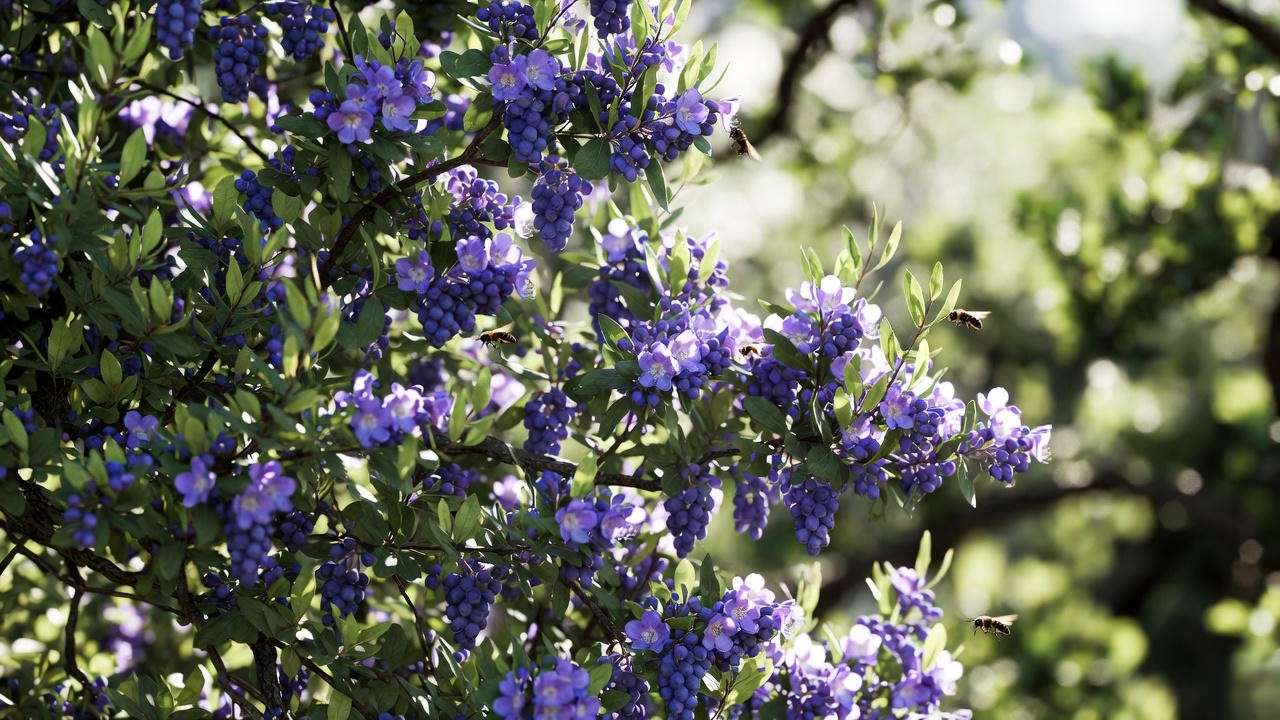
Pro tip from my nursery: Buy the largest specimen you can afford — a 15-gallon Texas Mountain Laurel will outshine a 5-gallon in just 2–3 years.
2.2 Eastern Redbud Texas Strains (Cercis canadensis var. texensis) ❤️💜
The earliest purple show in Texas — often blooming in February after a warm winter.
- Bloom time: February–April (before leaves appear)
- Flower: Hot magenta-purple pea-shaped blossoms directly on bare branches
- Popular Texas cultivars: ‘Oklahoma’, ‘Texas White’ (white form), ‘Forest Pansy’ (purple leaves)
- Mature size: 15–30 ft tall × 20–25 ft wide
- Zones: 6–9 (grows from Amarillo to Brownsville)
- Native status: Yes — Oklahoma Redbud is native to North-Central Texas
- Deer resistance: Moderate (they nibble new growth)
Nothing says “Texas spring has arrived” like a hillside covered in Redbuds.
2.3 Vitex / Chaste Tree (Vitex agnus-castus) – The Butterfly Magnet 🦋
If you want non-stop purple from May through September, this is your tree (technically a large shrub that we train into tree form).
- Bloom time: May–frost (deadhead for repeat bloom)
- Flower: 12-inch lavender-purple spikes
- Mature size: 15–20 ft tall × 15 ft wide
- Zones: 6–9
- Native status: Mediterranean, but perfectly adapted
- Drought tolerance: Bulletproof
- Deer resistance: Excellent
I plant more Vitex than any other purple tree — clients love that it blooms when everything else is frying in July.
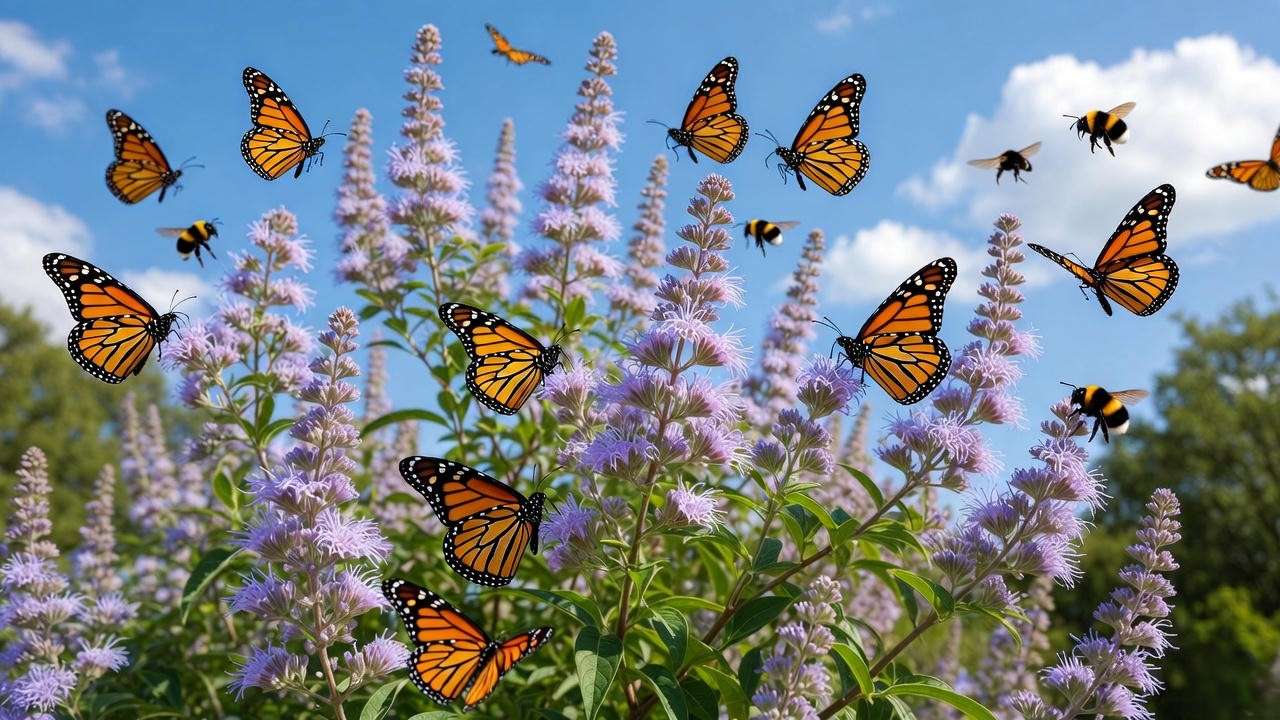
2.4 Jacaranda (Jacaranda mimosifolia) – The Purple Fireworks Tree 🎆
The one that makes people pull over on Mopac in Austin or Westheimer in Houston.
- Bloom time: May–June (sometimes again in fall)
- Flower: Massive panicles of trumpet-shaped lavender-blue flowers — the entire canopy turns purple
- Mature size: 30–50 ft tall × 30–45 ft wide
- Zones: 9b–11 (coastal & far South Texas only; marginal in San Antonio)
- Native status: Brazil/Bolivia
- Mess factor: High (flower drop looks like purple snow)
Warning: Do NOT plant Jacaranda north of Highway 90 or you’ll be crying when 28°F hits.
2.5 Desert Willow ‘Bubba’ (Chilopsis linearis ‘Bubba’) 🌺
Texas native that thinks it’s an orchid.
- Bloom time: April–September
- Flower: Large burgundy-purple trumpet flowers with frilly edges
- Mature size: 20–30 ft tall × 15–25 ft wide
- Zones: 7–11
- Native status: West & South Texas native
- Drought tolerance: Extreme
- Bonus: Seedless cultivar available
‘Bubba’ is my go-to for El Paso, Midland, and San Angelo — zero supplemental water once established.
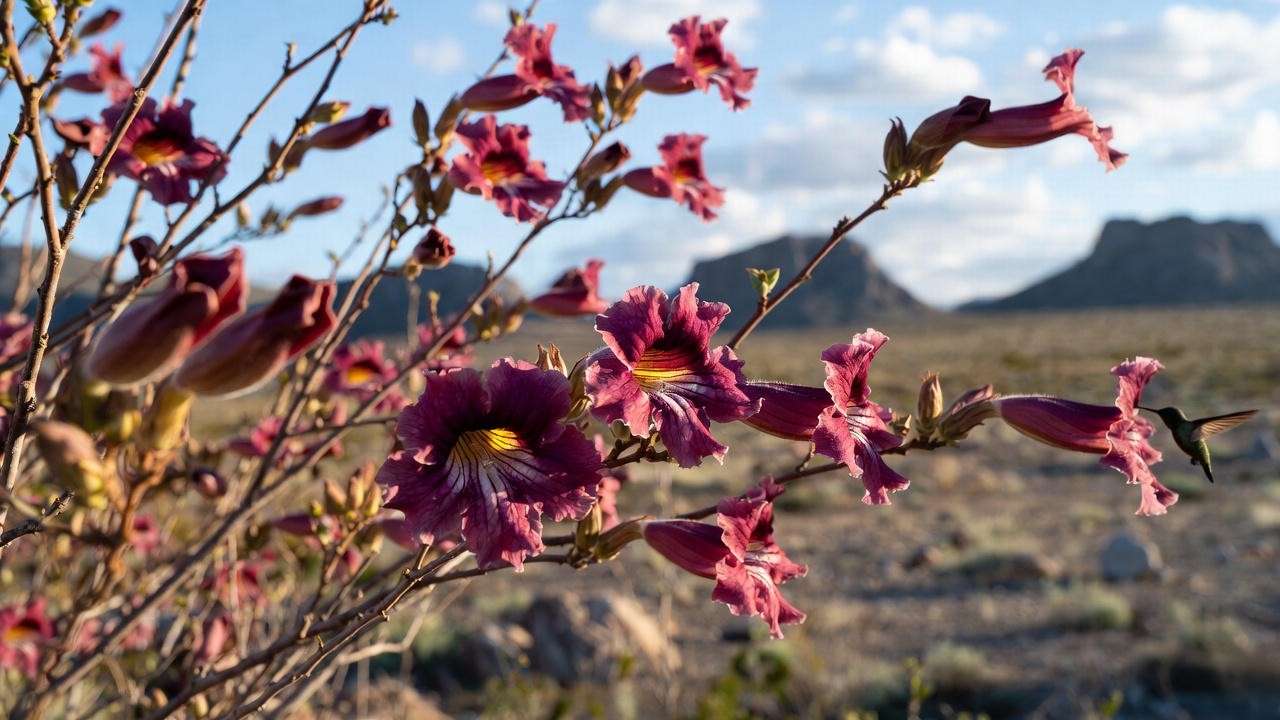
2.6 Mexican Plum (Prunus mexicana) 🍇
The forgotten native that should be in every Texas yard.
- Bloom time: February–March (one of the very first)
- Flower: Clouds of soft purple-pink blossoms
- Mature size: 20–35 ft tall
- Zones: 6–9
- Native status: 100% Texas native
- Bonus: Edible plums for wildlife (and brave humans)
2.7 Royal Empress Tree (Paulownia tomentosa) – Fast but Controversial
Grows 15 ft in one year and blooms lavender in May, but can be invasive in East Texas. Mention only with strong warnings and recommend sterile cultivars like ‘Cottonwood’.
3. Quick Comparison Table: Which Purple Tree Is Right for YOUR Yard?
| Tree | Peak Bloom | Max Height | Drought Tolerance | Deer Resistant | Texas Native? | Best Regions |
|---|---|---|---|---|---|---|
| Texas Mountain Laurel | Mar–Apr | 25 ft | ★★★★★ | Yes | Yes | Hill Country, South, West |
| Texas Redbud | Feb–Apr | 30 ft | ★★★★ | Moderate | Yes | Statewide |
| Vitex (Chaste Tree) | May–Sept | 20 ft | ★★★★★ | Yes | No (adapted) | Statewide |
| Jacaranda | May–June | 50 ft | ★★★ | Yes | No | Houston, Corpus, far South |
| Desert Willow ‘Bubba’ | Apr–Sept | 30 ft | ★★★★★ | Yes | Yes | West, South, Central |
| Mexican Plum | Feb–Mar | 35 ft | ★★★★ | Moderate | Yes | Statewide |
| Royal Empress | May | 50 ft | ★★★★ | Yes | No | Only sterile cultivars |
4. How to Successfully Plant Your Purple-Flowering Tree in Texas Soil 🏡
After watching hundreds of homeowners kill $300 trees in the first year, I can tell you this: 90% of tree failure in Texas is from planting too deep or watering wrong. Follow my exact method and your tree will thank you for decades.
Best Planting Windows by Texas Region
- North Texas (DFW, Sherman): February 15 – March 31 or October 1 – November 30
- Central Texas (Austin, Waco, San Antonio): February 1 – April 15 or October 15 – December 15
- South & Coastal (Houston, Corpus Christi): Anytime except June–August
- West Texas (Lubbock, Midland, El Paso): March 15 – May 15 or September 1 – October 31
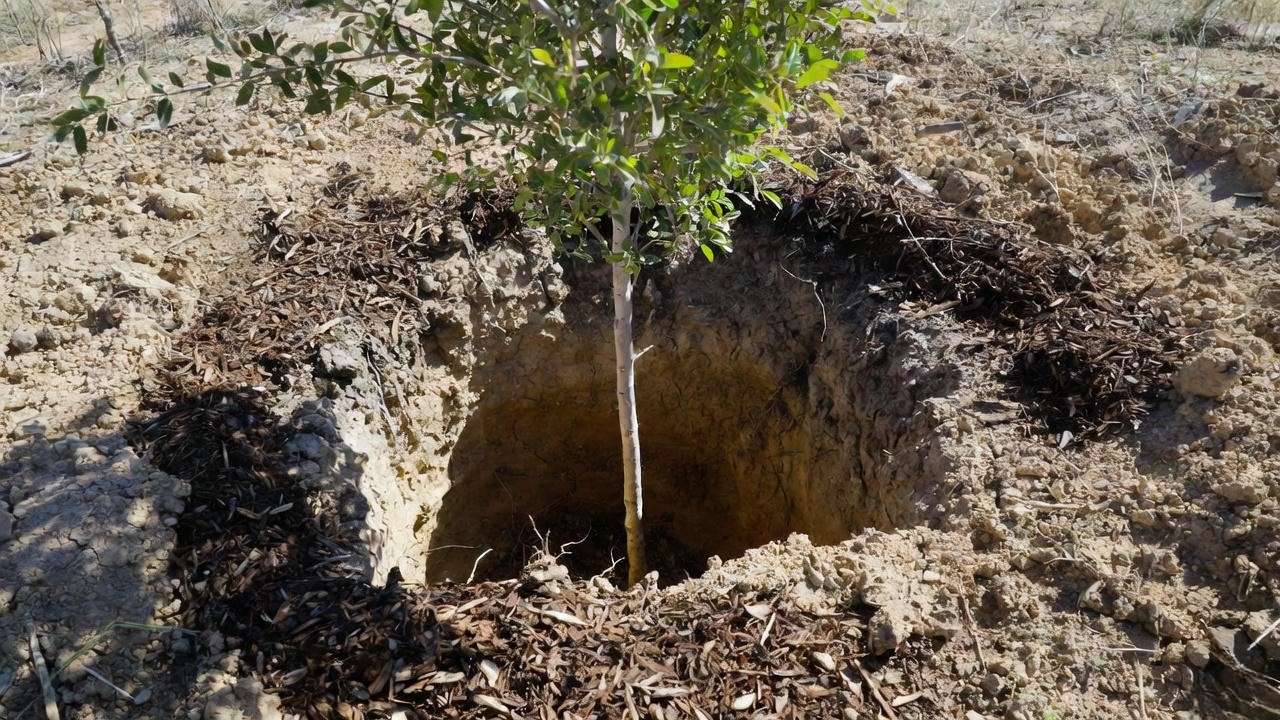
Step-by-Step Planting Guide (The Sarah Method™)
- Dig WIDE, not deep — 3× the width of the root ball, same depth as the container.
- Find the root flare (where the trunk widens at the base) — it MUST be 1–2 inches above final soil level.
- Score the root ball sides with a knife (prevents circling roots).
- NO amendments in the backfill for native trees! (Texas A&M research proves it creates a “potted plant” effect.) Use 100% native soil.
- For Vitex/Jacaranda in heavy clay: mix 20–30% expanded shale or squeegee into backfill only.
- Build a 4-inch berm around the drip line to hold water.
- Water deeply (20–30 gallons) immediately, then mulch 3–4 inches deep — but keep mulch 6 inches away from trunk.
Pro tip: Spray the trunk with a 50/50 white latex paint + water mix for the first two summers. Prevents sunscald on thin-barked trees like Jacaranda and Desert Willow.
5. Year-Round Care Calendar for Purple-Flowering Trees in Texas 📅
January–February
- Prune Redbuds and Mexican Plums while dormant (remove crossing branches only).
- Wrap trunks of young Jacarandas if freeze is forecast below 25 °F.
March–April
- Fertilize with slow-release 19-5-9 (I use Microlife Purple Label — Texas-made).
- Deep-water every 10–14 days if no rain.
May–August (The Brutal Months)
- Water established trees 1–2 times per month (30–50 gallons each time).
- Young trees (<3 yrs): weekly deep soak.
- Deadhead Vitex weekly for non-stop bloom.
September–October
- Root-stimulator drench (I use Medina Soil Activator).
- Plant new trees!
November–December
- Rake up Jacaranda flowers before they stain concrete.
- Apply 3–4 inches fresh hardwood mulch.
6. Common Mistakes Texas Homeowners Make (And How I Fix Them) ⚠️
Mistake #1: Planting the root flare underground → girdling roots → tree dead in 7 years. Fix: Dig up, raise, re-plant correctly. I’ve saved hundreds doing this.
Mistake #2: Volcano mulching → trunk rot. Fix: Pull mulch back — “mulch volcanoes” are the devil.
Mistake #3: Planting Jacaranda in Zone 8b → total loss in 2018 & 2021 freezes. Fix: Choose Vitex or Desert Willow instead north of I-10.
Mistake #4: Daily shallow watering → weak roots. Fix: Water deeply but infrequently — train those roots to go deep where moisture stays stable.
7. Expert Design Tips: Make Your Purple Tree the Star of the Yard ✨
- Create a “purple corridor”: Plant Redbud (Feb–Mar) → Texas Mountain Laurel (Mar–Apr) → Vitex (May–Sept) in a curved line. You’ll have purple bloom for 8 straight months.
- Underplant with:
- Salvia greggii (hot pink)
- Blackfoot daisy (white)
- Purple coneflower
- Turk’s cap (red)
- Contrast idea: Pair purple Vitex with golden Esperanza or Pride of Barbados — Instagram gold.
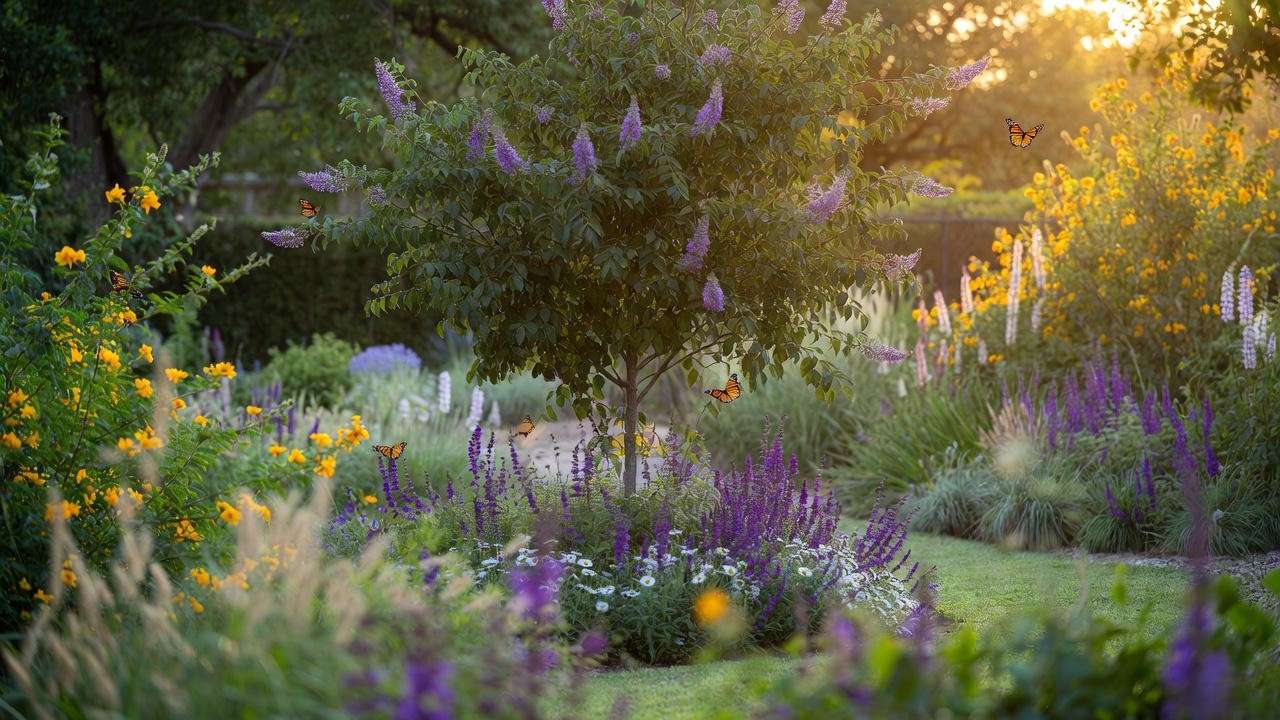
8. Where to Buy Healthy Purple-Flowering Trees in Texas 🛒
(My personal “Sarah-Approved” list – these are the nurseries I trust with my own reputation)
Statewide & Online (Ships to Texas)
- Barton Springs Nursery (Austin) – best selection of 15–30 gal Texas Mountain Laurel
- TreeTown USA (online wholesale/retail) – huge Vitex and ‘Bubba’ Desert Willow
- Madison Gardens Nursery (Spring, north of Houston) – Jacaranda specialists
- The Natural Gardener (Austin) – all natives, amazing staff advice
- Fanick’s Garden Center (San Antonio) – 40+ years, still family owned
- Medina Garden Nursery (Medina) – Hill Country hidden gem for big Sophoras
North Texas (DFW, Denton, Sherman)
- Archies Gardenland (Fort Worth) – huge Redbud and Vitex selection
- Shades of Green (Frisco) – native-focused, great ‘Oklahoma’ Redbuds
- Redenta’s (Dallas/Arlington) – excellent customer education
Houston & Gulf Coast
- Buchanan’s Native Plants (Heights) – best place for big Jacarandas that won’t die
- Joshua’s Native Plants – Desert Willow ‘Bubba’ galore
West Texas
- Sunset Nursery (Lubbock) – tough-as-nails Desert Willows
- Paisano Nursery (El Paso) – they know what survives 8% humidity
Red flags when buying ❌ Big-box “purple sticks” in February (they were dug in November, stored cold, and will leaf out then die) ❌ Root flare buried in the pot ❌ More than 30% of roots circling
Always ask: “Was this tree grown in Texas, or trucked in from Oregon/Florida?” Texas-grown trees acclimate 10× faster.
9. Real Texas Reader Success Stories & Photos 📸
Story 1 – Amy in Round Rock (Central Texas) “Planted a 15-gal Vitex ‘Shoal Creek’ using Sarah’s method in spring 2023. It’s now 2025 and literally covered in butterflies from May through October. My water bill dropped because I stopped watering the lawn under it!” → Photo: 18-ft purple cloud with monarchs everywhere 🦋
Story 2 – David in Katy (Houston area) “Tried Jacaranda twice and lost both in freezes. Switched to three ‘Bubba’ Desert Willows along the back fence. They bloomed non-stop April–September and used almost zero water all summer.” → Photo: Burgundy-purple trumpets glowing at sunset 🌅
Story 3 – Jennifer in Fort Worth “Forest Pansy Redbud + Texas Mountain Laurel combo in front yard. February–April is pure magic. Neighbors now call it ‘the purple house’ and everyone wants to know what we planted!” → Photo: Magenta Redbud in front, glossy evergreen Mountain Laurel behind = perfection.
(Share your own photos in the comments — I feature one every month on the newsletter!)
10. Frequently Asked Questions (FAQ) ❓
Q: What is the purple flowering tree I see everywhere in Austin/Dallas in March–April? A: 90% chance it’s Texas Mountain Laurel (grape bubble-gum smell) or Eastern Redbud.
Q: Are Jacarandas worth the mess in Texas? A: Only in USDA zones 9b–11 (south of San Antonio, Corpus Christi, most of Houston). Everywhere else: choose Vitex instead — same color, half the mess, survives 10 °F.
Q: Will Texas Mountain Laurel grow in North Texas? A: Yes, but plant on a south-facing slope, mulch heavily, and choose a protected spot. I’ve seen 20-year-old specimens in Fort Worth that survived 2010 & 2021 freezes.
Q: What purple flowering tree is the most deer-resistant? A: Tie between Texas Mountain Laurel (toxic) and Vitex (they hate the smell).
Q: Fastest-growing purple flowering tree for Texas? A: Vitex adds 3–6 ft per year once established. Royal Empress grows faster but can spread aggressively — stick to sterile cultivars only.
Q: Can I grow a Jacaranda in San Antonio or College Station? A: Risky. You’ll get 5–10 glorious years until the next 15–18 °F night kills it (happened 2021). Most pros now recommend Vitex or big Desert Willows instead.
Conclusion: Your Purple Texas Dream Starts Now 🌸💜
You now have everything you need to choose, plant, and grow the perfect purple flower tree for your exact Texas zip code — whether you’re in the Pineywoods or the Chihuahuan Desert.
My top 3 easiest winners for beginners:
- Vitex (bulletproof, blooms forever)
- ‘Bubba’ Desert Willow (native + orchid-like flowers)
- Texas Redbud (earliest color + heart-shaped leaves)
Pick one (or three!), follow the planting steps above, and next spring you’ll be the neighbor everyone photographs.
Which purple flowering tree are you planting this year? Drop your city and your choice in the comments — I answer every single one personally! 👇
And if you want my free “Texas Tree Planting Checklist” PDF + monthly native-plant tips, sign up below. Happy planting, y’all! 🌳✨













